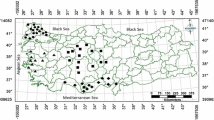Abstract
Persistent organic pollutants (POPs) constitute a wide range of chemicals. Their release into the environment has raised great concern due to their potentially harmful impact in humans and wildlife species. The aim of this current study was to detect selected POPs in hair samples of wild terrestrial mammals from Primorsky Krai, Russia, so as to assess potential environmental exposure. The tested wild species were leopard cat, musk deer, wolf, amur hedgehog, and raccoon dog. The targeted organochlorines were hexachlorobenzene (HCB) and DDTs (opDDE, ppDDE, and opDDD), polychlorinated biphenyl (PCB) congeners (28, 52, 101, 118, 138, 153, and 180), and polycyclic aromatic hydrocarbons (PAHs) (acenaphylene (ACEN), fluorene (FLU), anthracene (ANTH) phenathrene (PHEN), and pyrene (PYR)). The detection of POPs was conducted in hair samples by a one-step hair extraction method, by using a headspace solid-phase microextraction technique (HS-SPME) and analyzed then by GC-MS. The majority of the wild animal hair samples were found positive in all tested pollutants. More specifically, the percentage of positive hair samples for HCB was 93.3% and for DDTs, PCBs, and PAHs, 20.0 to 100.0%, 6.7 to 100.0%, and 75.0 to 100.0%, respectively. DDT, PCB, and PAH detection ranged from 1.26 to 52.06 pg mg−1, 0.73 to 31.34 pg mg−1, and 2.59 to 35.00 pg mg−1, respectively. The highest mean concentration levels of all tested pollutants were found for musk deer (PCBs 12.41 pg mg−1, DDTs 21.87 pg mg−1, PAHs 22.12 pg mg−1) compared to the other wild species. To the best of our knowledge, this is the first study that provides results regarding contamination in different terrestrial mammals by POP exposure. The use of hair as a matrix is proven to be an effective tool for nondestructive biological monitoring of POP contamination in terrestrial ecosystems.




Similar content being viewed by others
References
Ali N, Malik RN, Mehdi T, Eqani SAMAS, Javeed A, Neels H, Covaci A (2013) Organohalogenated contaminants (OHCs) in the serum and hair of pet cats and dogs: biosentinels of indoor pollution. Sci Total Environ 449:29–36. https://doi.org/10.1016/j.scitotenv.2013.01.037
Barbounis EG, Tzatzarakis MN, Alegakis AK, Kokkinaki A, Karamanos N, Tsakalof A, Tsatsakis AM (2012) Assessment of PCBs exposure in human hair using double focusing high resolution mass spectrometry and single quadrupole mass spectrometry. Toxicol Lett 210:225–231. https://doi.org/10.1016/j.toxlet.2011.07.031
Cabrerizo A, Dachs J, Barceló D, Jones KC (2012) Influence of organic matter content and human activities on the occurrence of organic pollutants in Antarctic soils, lichens, grass, and mosses. Environ Sci Technol 46:1396–1405. https://doi.org/10.1021/es203425b
Covaci A, Tutudaki M, Tsatsakis AM, Schepens P (2002) Hair analysis: another approach for the assessment of human exposure to selected persistent organochlorine pollutants. Chemosphere 46:413–418. https://doi.org/10.1016/S0045-6535(01)00065-0
Covaci A, Hura C, Gheorghe A, Neels H, Dirtu AC (2008) Organochlorine contaminants in hair of adolescents from Iassy, Romania. Chemosphere 72:16–20. https://doi.org/10.1016/j.chemosphere.2008.02.058
D’Havé H, Scheirs J, Covaci A et al (2006) Nondestructive pollution exposure assessment in the european hedgehog (Erinaceuseuropaeus): III. Hair as an indicator of endogenous organochlorine compound concentrations. Environ Toxicol Chem 25:158–167. https://doi.org/10.1897/05-208R.1
Dahmardeh Behrooz R, Barghi M, Bahramifar N, Esmaili-Sari A (2012) Organochlorine contaminants in the hair of Iranian pregnant women. Chemosphere 86:235–241. https://doi.org/10.1016/j.chemosphere.2011.09.031
González-Gómez X, Cambeiro-Pérez N, Martínez-Carballo E, Simal-Gándara J (2018) Screening of organic pollutants in pet hair samples and the significance of environmental factors. Sci Total Environ 625:311–319. https://doi.org/10.1016/j.scitotenv.2017.12.270
Grassman LI (2000) Movements and diet of the leopard cat Prionailurusbengalensis in a seasonal evergreen forest in south-central Thailand. Acta Theriol 45:421–426. https://doi.org/10.4098/AT.arch.00-41
He C-T, Yan X, Wang M-H, Zheng XB, Chen KH, Guo MN, Zheng J, Chen SJ (2017) Dichloro-diphenyl-trichloroethanes (DDTs) in human hair and serum in rural and urban areas in South China. Environ Res 155:279–286. https://doi.org/10.1016/j.envres.2017.02.011
HercegRomanić S, Klinčić D, Kljaković-Gašpić Z et al (2015) Organochlorine pesticides and polychlorinated biphenyl congeners in wild terrestrial mammals from Croatia: interspecies comparison of residue levels and compositions. Chemosphere 137:52–58. https://doi.org/10.1016/j.chemosphere.2015.05.026
Imbert C, Caniglia R, Fabbri E, Milanesi P, Randi E, Serafini M, Torretta E, Meriggi A (2016) Why do wolves eat livestock?: factors influencing wolf diet in northern Italy. Biol Conserv 195:156–168. https://doi.org/10.1016/j.biocon.2016.01.003
Jaspers VLB, Dietz R, Sonne C, Letcher RJ, Eens M, Neels H, Born EW, Covaci A (2010) A screening of persistent organohalogenated contaminants in hair of East Greenland polar bears. Sci Total Environ 408:5613–5618. https://doi.org/10.1016/j.scitotenv.2010.07.059
Katsikantami I, Sifakis S, Tzatzarakis M et al (2016) A global assessment of phthalates burden and related links to health effects. Environment International 97:212–236. https://doi.org/10.1016/j.envint.2016.09.013
Kavvalakis M, Tsatsakis A (2012) The atlas of dialkylphosphates; assessment of cumulative human organophosphorus pesticides’ exposure. Forensic Sci Int 218:111–122. https://doi.org/10.1016/j.forsciint.2011.10.019
Liang B, Liu X, Hou J, Liang G, Gong W, Xu D, Zhang L (2014) PCBs levels and indicator congeners in children’s and adolescents’ hair. Environ Pollut 185:10–15. https://doi.org/10.1016/j.envpol.2013.10.014
Malarvannan G, Isobe T, Covaci A, Prudente M, Tanabe S (2013) Accumulation of brominated flame retardants and polychlorinated biphenyls in human breast milk and scalp hair from the Philippines: levels, distribution and profiles. Sci Total Environ 442:366–379. https://doi.org/10.1016/j.scitotenv.2012.10.005
Mamontova EA, Mamontov AA, Tarasova EN, Kuzmin MI, Ganchimeg D, Khomutova MY, Gombosuren O, Ganjuurjav E (2013) Polychlorinated biphenyls in surface soil in urban and background areas of Mongolia. Environ Pollut 182:424–429. https://doi.org/10.1016/j.envpol.2013.08.001
Mizukawa H, Nomiyama K, Nakatsu S, Yachimori S, Hayashi T, Tashiro Y, Nagano Y, Tanabe S (2013) Species-specific differences in the accumulation features of organohalogen contaminants and their metabolites in the blood of Japanese terrestrial mammals. Environ Pollut 174:28–37. https://doi.org/10.1016/j.envpol.2012.11.004
Sutor A, Kauhala K, Ansorge H (2010) Diet of the raccoon dog Nyctereutesprocyonoides — a canid with an opportunistic foraging strategy. Acta Theriol 55:165–176. https://doi.org/10.4098/j.at.0001-7051.035.2009
Tartu S, Bourgeon S, Aars J, et al (2017) Sea ice-associated decline in body condition leads to increased concentrations of lipophilic pollutants in polar bears (Ursus maritimus) from Svalbard, Norway. Sci Total Environ 576:409–419. https://doi.org/10.1016/j.scitotenv.2016.10.132
Tomza-Marciniak A, Marciniak A, Pilarczyk B, Prokulewicz A, Bąkowska M (2014) Interspecies comparison of chlorinated contaminant concentrations and profiles in wild terrestrial mammals from Northwest Poland. Arch Environ Contam Toxicol 66:491–503. https://doi.org/10.1007/s00244-013-9989-y
Tsatsakis A, Tutudaki M (2004) Progress in pesticide and POPs hair analysis for the assessment of exposure. Forensic Sci Int 145:195–199. https://doi.org/10.1016/j.forsciint.2004.04.036
Tsatsakis A, Barbounis M, Kavalakis M (2010) Determination of dialkyl phosphates in human hair for the biomonitoring of exposure to organophosphate pesticides. J Chromatogr B – Anal Technol Biomed Life Sci 878:1246–1252. https://doi.org/10.1016/j.jchromb.2010.02.021
Tzatzarakis M, BE G, KM P et al (2014) Rapid method for the simultaneous determination of DDTs and PCBs in hair of children by headspace solid phase microextraction and gas chromatography-mass spectrometry (HSSPME/GC-MS). Drug Test Anal 6:85–92. https://doi.org/10.1002/dta.1631
Vinceti M, Violi F, Tzatzarakis M, Mandrioli J, Malagoli C, Hatch EE, Fini N, Fasano A, Rakitskii VN, Kalantzi OI, Tsatsakis A (2017) Pesticides, polychlorinated biphenyls and polycyclic aromatic hydrocarbons in cerebrospinal fluid of amyotrophic lateral sclerosis patients: a case-control study. Environ Res 155:261–267. https://doi.org/10.1016/j.envres.2017.02.025
Wang W, Zhou R, He L, Liu S, Zhou J, Qi L, Li L, Hu D (2015) The progress in nutrition research of musk deer: implication for conservation. Appl Anim Behav Sci 172:1–8. https://doi.org/10.1016/j.applanim.2015.09.006
Warenik-Bany M, Strucinski P, Piskorska-Pliszczynska J (2016) Dioxins and PCBs in game animals: interspecies comparison and related consumer exposure. Environ Int 89–90:21–29. https://doi.org/10.1016/j.envint.2016.01.007
Yamamoto Y, Ishizaki A, Kataoka H (2015) Biomonitoring method for the determination of polycyclic aromatic hydrocarbons in hair by online in-tube solid-phase microextraction coupled with high performance liquid chromatography and fluorescence detection. J Chromatogr B 1000:187–191. https://doi.org/10.1016/j.jchromb.2015.07.033
Zapletal M, Sodnompil B, Atwood JL, Murdoch JD, Reading RP (2015) Fine-scale habitat use by Daurian hedgehogs in the Gobi-steppe of Mongolia. J Arid Environ 114:100–103. https://doi.org/10.1016/j.jaridenv.2014.11.010
Acknowledgements
This work was supported by the Russian Science Foundation (project No. 18-14-00120).
Author information
Authors and Affiliations
Corresponding author
Ethics declarations
Conflict of interest
The authors declare that they have no conflict of interest.
Additional information
Responsible editor: Ester Heath
Publisher’s note
Springer Nature remains neutral with regard to jurisdictional claims in published maps and institutional affiliations.
Electronic supplementary material
ESM 1
(DOCX 97 kb)
Rights and permissions
About this article
Cite this article
Iatrou, E.I., Tsygankov, V., Seryodkin, I. et al. Monitoring of environmental persistent organic pollutants in hair samples collected from wild terrestrial mammals of Primorsky Krai, Russia. Environ Sci Pollut Res 26, 7640–7650 (2019). https://doi.org/10.1007/s11356-019-04171-9
Received:
Accepted:
Published:
Issue Date:
DOI: https://doi.org/10.1007/s11356-019-04171-9




